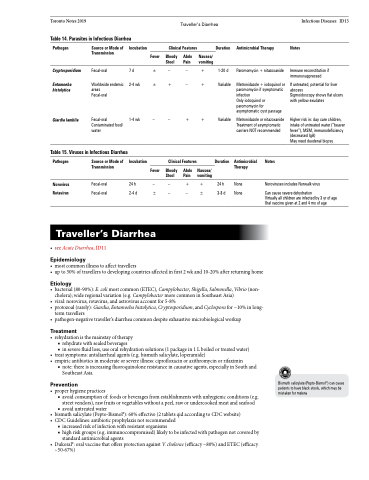Page 613 - TNFlipTest
P. 613
Toronto Notes 2019
Traveller’s Diarrhea
Infectious Diseases ID13
Table 14. Parasites in Infectious Diarrhea
Pathogen
Cryptosporidium
Entamoeba histolytica
Giardia lamblia
Source or Mode of Transmission
Fecal-oral
Worldwide endemic areas
Fecal-oral
Fecal-oral Contaminated food/ water
Incubation
Clinical Features Duration
Fever Bloody Abdo Nausea/ Stool Pain vomiting
Antimicrobial Therapy
Paromomycin + nitazoxanide
Metronidazole + iodoquinol or paromomycin if symptomatic infection
Only iodoquinol or paromomycin for asymptomatic cyst passage
Metronidazole or nitazoxanide Treatment of asymptomatic carriers NOT recommended
Antimicrobial Notes Therapy
Notes
Immune reconstitution if immunosuppressed
If untreated, potential for liver abscess
Sigmoidoscopy shows flat ulcers with yellow exudates
Higher risk in: day care children, intake of untreated water (“beaver fever”), MSM, immunodeficiency (decreased IgA)
May need duodenal biopsy
7 d ± – – + 1-20 d
2-4 wk ±
1-4 wk –
Incubation
24 h 2-4 d
+ –
– +
Clinical Features
+
+
Variable
Variable
Duration
24 h 3-8 d
Table 15. Viruses in Infectious Diarrhea
Pathogen
Norovirus Rotavirus
Source or Mode of Transmission
Fecal-oral Fecal-oral
Fever Bloody Abdo Nausea/
Stool
– – ± –
Pain vomiting
+ + – ±
None Noroviruses includes Norwalk virus
None Can cause severe dehydration
Virtually all children are infected by 3 yr of age
Oral vaccine given at 2 and 4 mo of age
Traveller’s Diarrhea
• seeAcuteDiarrhea,ID11
Epidemiology
• mostcommonillnesstoaffecttravellers
• upto50%oftravellerstodevelopingcountriesaffectedinfirst2wkand10-20%afterreturninghome
Etiology
• bacterial(80-90%):E.colimostcommon(ETEC),Campylobacter,Shigella,Salmonella,Vibrio(non- cholera); wide regional variation (e.g. Campylobacter more common in Southeast Asia)
• viral:norovirus,rotavirus,andastrovirusaccountfor5-8%
• protozoal(rarely):Giardia,Entamoebahistolytica,Cryptosporidium,andCyclosporafor~10%inlong-
term travellers
• pathogen-negativetraveller’sdiarrheacommondespiteexhaustivemicrobiologicalworkup
Treatment
• rehydrationisthemainstayoftherapy
■ rehydrate with sealed beverages
■ in severe fluid loss, use oral rehydration solutions (1 package in 1 L boiled or treated water)
• treatsymptoms:antidiarrhealagents(e.g.bismuthsalicylate,loperamide)
• empiricantibioticsinmoderateorsevereillness:ciprofloxacinorazithromycinorrifaximin
■ note: there is increasing fluoroquinolone resistance in causative agents, especially in South and Southeast Asia
Prevention
• properhygienepractices
■ avoid consumption of: foods or beverages from establishments with unhygienic conditions (e.g.
street vendors), raw fruits or vegetables without a peel, raw or undercooked meat and seafood ■ avoid untreated water
• bismuthsalicylate(Pepto-Bismol®):60%effective(2tabletsqidaccordingtoCDCwebsite)
• CDCGuidelines:antibioticprophylaxisnotrecommended
■ increased risk of infection with resistant organisms
■ high risk groups (e.g. immunocompromised) likely to be infected with pathogen not covered by
standard antimicrobial agents
• Dukoral®:oralvaccinethatoffersprotectionagainstV.cholerae(efficacy~80%)andETEC(efficacy
Bismuth salicylate (Pepto-Bismol®) can cause patients to have black stools, which may be mistaken for melena
~50-67%)


